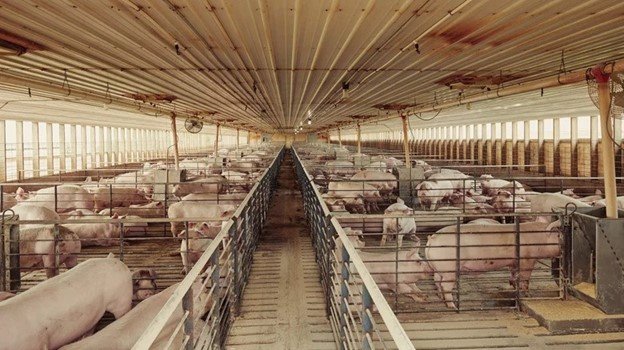Grow /
Studio Roosegaarde, Dutch
Grow, 2021
The interconnection between science and art comes to life with Roosegaarde’s Grow installation in the Netherlands. Using light recipes consisting of red, blue, and ultraviolet, the dancing colors are projected across a leek field. These colors are scientifically proven to enhance plant growth and reduce the use of harmful pesticides that pollute our environment. This dreamscape illuminates the need for sustainable farming while simultaneously offering a scientific solution through art. Grow reframes agriculture, calling us to appreciate its beauty and what it provides to us, while encouraging new innovations that will prioritize the health of our environment and all living creatures. Label by Bayleigh Albert
Hog Hallway /
Anabelle Doliner, American
Hog Hallway, 2022
This image is of a hog farm in rural Iowa. Doliner frames the pig cages over a symmetrical line, with metal bars emphasizing the factory aspect of this type of farm. Feed comes from metal boxes and for the entirety of the farm there is a single fan. The floor is grated for waste to drop into an industrial tank. Organic shapes exist solely in the pigs, the only natural or living element. The monochrome beige colors show how bleak the industry is. It shows how we have reshaped nature for our own consumption. This exploitation is ugly and sad. Label by Lucas Theobald
The Beef-Trust /
Carl Hassmann, American
The Beef-Trust, 1906
In this 1906 caricature of a butchers shop, published in the American satirical magazine Puck, the butcher leers at the viewer in macabre commentary. He is surrounded by cans, casings, and other things all with labels including “tuberculosis lard,” “potted poison,” “decayed roast beef,” and more unpleasant names. A bible verse appears underneath the image, saying “Therefore I tell you, do not worry about your life, what you will eat or drink,” ironically mocking the Christian-built capitalism that was then poisoning the food supply with little care. As famously addressed in Upton Sinclair’s The Jungle, published the same year, this capitalism is the continuing force that decays our health and environment. Label by Annabelle Marcais









